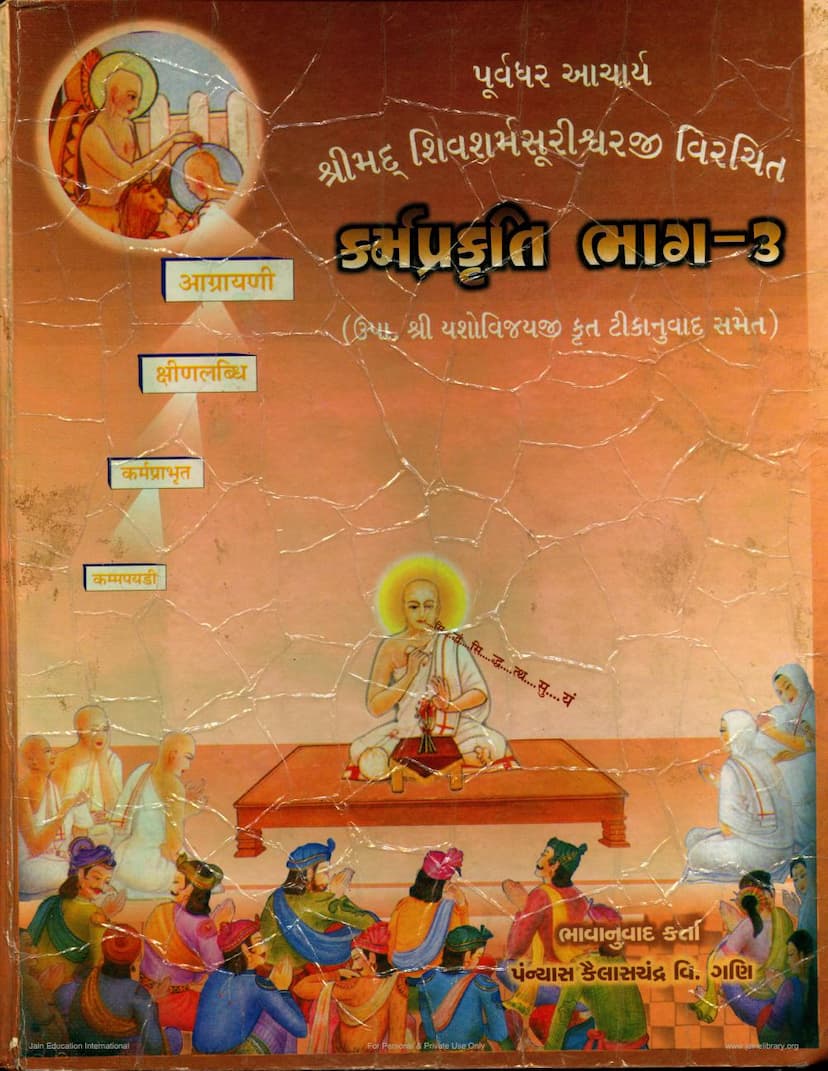Karm Prakruti Part 03
Added to library: September 2, 2025

Summary
The provided text is the third part of a Jain scripture titled "Karm Prakruti Part 03" authored by Kailashchandravijay and published by Rander Road Jain Sangh. This volume delves deeply into the intricate concepts of Jain karma theory, specifically focusing on the "Uday Prakaran" (Chapter on Manifestation/Uday) and the "Satta Prakaran" (Chapter on Existence/Satta).
Here's a breakdown of the key aspects covered in the text:
Core Theme: Understanding Karma
The text is fundamentally about understanding the nature of karma, its manifestation (Uday), and its enduring presence (Satta) within the soul according to Jain philosophy. It aims to provide a detailed and systematic explanation of how karmic particles (Karmas) influence the soul's journey through the cycle of birth and death.
Key Concepts Explained:
-
Uday Prakaran (Chapter on Manifestation): This section meticulously explains the "Uday" of karmas, which refers to how karmic impressions ripen and manifest their effects in the soul's experience. It details:
- Prakruti Uday (Nature of Manifestation): How different types of karmas (e.g., Jnanavarniya, Darshanavarniya, Vedaniya, Mohaniya, Ayushya, Namakarma, Gotrakarma, Antaraya) manifest based on their inherent nature.
- Sthiti Uday (State of Manifestation): How the duration of karmic influence (Sthiti) affects its manifestation.
- Anubhag Uday (Intensity of Manifestation): How the intensity or quality of karmic influence (Anubhaga or Ras) impacts the experience.
- Pradesh Uday (Scope of Manifestation): How the extent or quantity of karmic particles (Pradesh) affects the manifestation.
- The Eight Karanas (Actions related to Karma): The text likely elaborates on the eight types of actions (Bandha, Uddirna, Uday, Satta, Sankrama, Udvarta, Apavartana, Utkripana) that influence karma, though the summary focuses on Uday and Satta.
- Influence of Soul States (Gunasthanas): How the soul's spiritual progress through the 14 Gunasthanas affects the type, intensity, and scope of karmic manifestation.
- Influence of Life Forms (Gati): How the soul's current life form (Narak, Tiryanch, Manushya, Dev) impacts karmic manifestation.
- Influence of States of Consciousness (Leshya): How the soul's subtle emotional states influence karmic effects.
- Influence of Effort (Yog): How different types of mental, verbal, and physical activities (Yog) affect karma.
- Detailed Breakdowns: The text provides intricate details on the number of possible "Bhangas" (variations or combinations) for different karmas based on the interplay of these factors (Gati, Gunasthana, Yog, Leshya, etc.).
-
Satta Prakaran (Chapter on Existence): This section focuses on "Satta," which refers to the latent potential or the enduring presence of karmic particles that have been bound but have not yet manifested. It covers:
- Prakruti Satta (Existence of Nature): How the fundamental nature of karmas (Mool Prakruti and Uttar Prakruti) exists in the soul. It categorizes them as permanent (Dhruva) or impermanent (Adhruva) and originating from beginningless (Anadi) or with a beginning (Sadi).
- Sthiti Satta (Existence of State/Duration): How the duration of karma remains in a latent state.
- Anubhag Satta (Existence of Intensity): How the intensity or quality of karma remains latent.
- Pradesh Satta (Existence of Scope/Quantity): How the quantity of karmic particles remains latent.
- Interplay with Gunasthana: Similar to Uday, the chapter explains how the soul's spiritual state (Gunasthana) influences the existence and potency of latent karmas.
- Samyog (Conjunction/Interplay): The text details the complex ways in which different karmas interact with each other and with the soul's state (Gunasthana, Gati, etc.) in terms of their existence.
Structure and Content:
The provided pages offer a glimpse into the book's structure:
- Title Pages & Acknowledgements: The initial pages contain the title, author, publisher, and acknowledgments, highlighting the contributions of various Jain scholars and institutions. It also features blessings and dedications to revered Acharyas.
- Introduction/Preface: The preface (Prastavana) likely sets the stage, possibly explaining the importance of studying karma and the purpose of this particular volume. It might draw parallels with worldly concepts to illustrate the pervasiveness of karma.
- Detailed Explanation of Uday and Satta: The bulk of the text is dedicated to elaborating on the permutations and combinations of Uday and Satta for various karmic types across different Gunasthanas, Gatis, Yogas, and Leshyas.
- Tables and Diagrams (Yantras): The inclusion of "Yantras" (diagrams or tables) is crucial for visualizing these complex relationships and classifications within Jain karma theory. Page 4 explicitly mentions these diagrams.
- Questions and Answers (Prashnottari): The inclusion of a "Prashnottari" section suggests a pedagogical approach, aiming to clarify doubts and reinforce understanding of the intricate concepts.
- Appendices (Parishisht): The text includes appendices with detailed tables summarizing the classifications and interactions of karmic manifestations and states.
Key Figures Mentioned:
The text pays homage to several revered Jain Acharyas and scholars, including:
- Purdhar Acharya Shrimad Shivshurishwarji (original author of Karm Prakriti)
- Upadhyaya Shrimad Yashovijayji (commentator)
- Acharya Shrimad Malayagiri Maharaaj (commentator)
- Acharya Shrimad Munichandrasurishwarji (commentator)
- Pujyapad Acharya Shrimad Vijay Nemivijnan Kastursurishwarji and his lineage of Gurus (for inspiration and support).
- Panditvar Shri Chhabiladas Keshrichand and other scholars who contributed to the translation and compilation.
Overall Purpose:
The "Karm Prakruti Part 03" is a scholarly and comprehensive work within Jain literature. Its primary aim is to provide an exhaustive and detailed understanding of karmic manifestation and existence according to Jain metaphysics. It serves as a foundational text for serious students of Jainism seeking to grasp the complex mechanics of karma that govern the soul's rebirth and spiritual progression towards liberation (Moksha). The emphasis on detailed classifications, intricate interrelations, and explanations through various spiritual states and life forms highlights the depth of Jain philosophical inquiry.